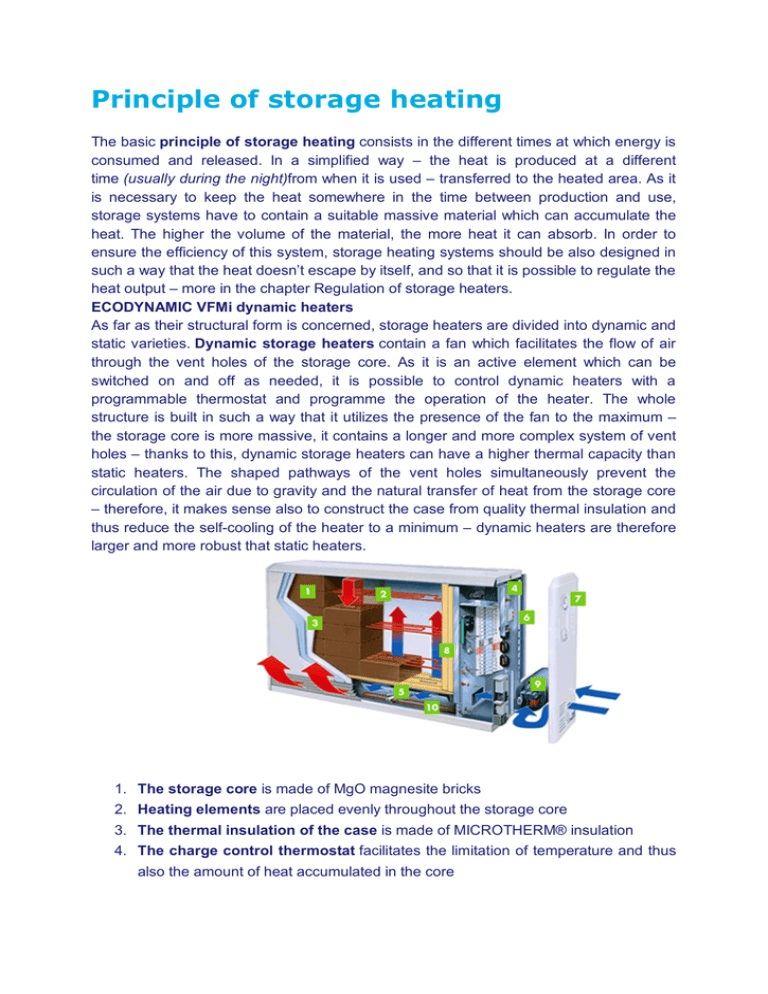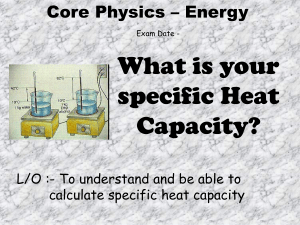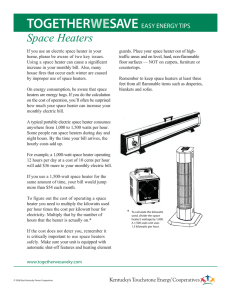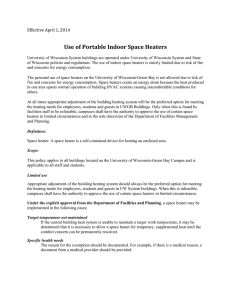Principle of storage heating
advertisement

Principle of storage heating The basic principle of storage heating consists in the different times at which energy is consumed and released. In a simplified way – the heat is produced at a different time (usually during the night)from when it is used – transferred to the heated area. As it is necessary to keep the heat somewhere in the time between production and use, storage systems have to contain a suitable massive material which can accumulate the heat. The higher the volume of the material, the more heat it can absorb. In order to ensure the efficiency of this system, storage heating systems should be also designed in such a way that the heat doesn’t escape by itself, and so that it is possible to regulate the heat output – more in the chapter Regulation of storage heaters. ECODYNAMIC VFMi dynamic heaters As far as their structural form is concerned, storage heaters are divided into dynamic and static varieties. Dynamic storage heaters contain a fan which facilitates the flow of air through the vent holes of the storage core. As it is an active element which can be switched on and off as needed, it is possible to control dynamic heaters with a programmable thermostat and programme the operation of the heater. The whole structure is built in such a way that it utilizes the presence of the fan to the maximum – the storage core is more massive, it contains a longer and more complex system of vent holes – thanks to this, dynamic storage heaters can have a higher thermal capacity than static heaters. The shaped pathways of the vent holes simultaneously prevent the circulation of the air due to gravity and the natural transfer of heat from the storage core – therefore, it makes sense also to construct the case from quality thermal insulation and thus reduce the self-cooling of the heater to a minimum – dynamic heaters are therefore larger and more robust that static heaters. 1. The storage core is made of MgO magnesite bricks 2. Heating elements are placed evenly throughout the storage core 3. The thermal insulation of the case is made of MICROTHERM® insulation 4. The charge control thermostat facilitates the limitation of temperature and thus also the amount of heat accumulated in the core 5. The bypass system opens automatically when an auxiliary heating element is heated 6. Wall bracket with distancing openings for the installation of a supply conductor 7. The controller for the charge control thermostat is placed on the side of the heater 8. The inner insulation of the core is from VERMIKULIT thermal insulation 9. The radial fan facilitates the air flow through the storage core 10. The auxiliary heating element enables heating even if the whole thermal capacity of the heater has been used up It is usually possible to supplement dynamic storage heaters with an auxiliary heater (heating bar), which is switched on when the whole thermal capacity of the storage heater has been used up. As the auxiliary heater is connected from a nonblocked circuit and is thus operated in the high (expensive)tariff period, it is necessary to design the size of the storage heater correctly and limit the operation of this auxiliary heater to a minimum. Auxiliary heating mainly functions as back-up heating – for example in situations when the charging of the heater is limited by the user with regards to temperature but unexpected cooling occurs the next day and the capacity of the heater is used up faster than expected. Auxiliary heating for ECODYNAMIC storage heaters In applications where ECODYNAMIC dynamic storage heaters are used and where, under exceptional circumstances, the thermal capacity of the heater is insufficient, it makes no sense to install a more powerful type of heater – the missing output can be supplemented with the installation of auxiliary heating directly into the storage heater. Additional heating bars are placed in the heater’s air outlet and these make the air warmer if needed. This auxiliary heating is connected from a non-blocked circuit and is also powered in the high tariff period – the dynamic heater than behaves as a directheating device. In the terminal of the storage heater there are connectors which are reserved for the connection of auxiliary heating – this circuit is lead through a thermostat which switches the current into the auxiliary heating only if the temperature of the storage core drops under 30°C. Auxiliary heating elements for ECODYNAMIC storage heaters * Auxiliary heating isn’t a standard part of the supplied equipment Heating element type For Ecodynamic type Wattage (kW) ZHi 050 E WFMi 20 0,5 ZHi 070 E WFMi 30-70 0,7 ZHi 110 E WFMi 40-70 1,1 ZHi 150 E WFMi 50-70 1,5 ZHi 200 E WFMi 50-70 2,0 ECOSTATIC WMX static heaters Static storage heaters are a simpler and cheaper alternative to dynamic heaters. These heaters don’t have a fan and therefore their construction must enable self-cooling of the core by the air which flows due to circulation under the influence of gravity on the basis of air differences – the vent hole in the storage bricks is shorter and direct. Also, the insulation of the case is lower so that the heater can transfer part of its heat also via its case. Expressed as a ratio, static heaters transfer approximately ¾ of their heat via convection via the airing of their storage cores, and about ⅓ of the heat via the surface of the heater – convection and radiation. As static storage heaters transfer part of their heat also through the case (the type WMX 706 heater has no vent holes at all and transfers heat exclusively via its surface), the heat release from the heater cannot be stopped completely even if the flaps are closed fully. The heater thus gradually cools down by itself – and is therefore suitable mainly for buildings with lower requirements for precise temperature regulation. 1. The front wall of the casing 2. Thermal insulation of the core 3. Storage core consisting of MgO magnesite bricks 4. Vent holes in the storage core 5. The top side of the casing rounds off the heater’s design 6. The deflector leads the heat to the air outlet grills 7. The regulation flap limits the amount of flowing air 8. The outlet hole slows down the circulation for better heat release 9. The heating element can also work in direct-heating mode 10. Thermal insulation of the bottom part of the heater 11. Inlet openings for cold air Apart from a thermostat which controls the regulation flaps, static heaters also contain another electromechanical thermostat which enables the limitation of the temperature of the storage core(charge limitation) and thus reduces the amount of accumulated heat (thermal capacity) of the heater according to current climatic conditions. Static storage heaters can also be used in direct-heating mode – the heater than behaves as a standard direct-heating convector with storage capacity. However, this method of connecting also makes regulation problematic – more in the chapter Regulation of storage heaters.




